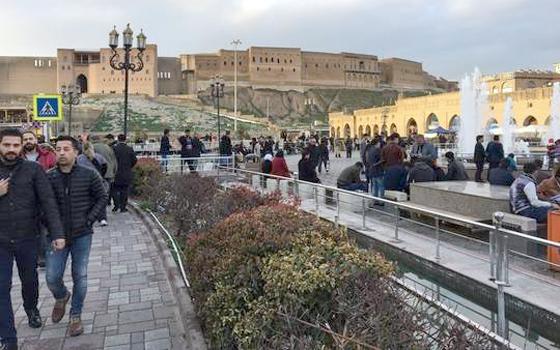From a distance, the Erbil city skyline is impressive. At first glance, there seems to be an architectural free-for-all in design application. High-rise buildings twist and turn and slant sideways and not from poor construction. Planned developments, both commercial and residential, sprout mostly on the north side within an easy drive of the international airport. An up-close look, though, belies much of the economic trauma that afflicts the Kurdistan region today.
When your primary source of national wealth comes from oil and gas extraction and the price of oil runs near $120 a barrel, then all is well. However, when it drops to $40 a barrel with little making up the difference, then all is not well. Couple that at the time with the invasion of Iraq by the Islamic State horde and economic hard times set in. What “little” there was, foreign investment, left as the IS advanced. Hence, the abundance of partially finished high-rise buildings as there was little money or incentive to complete them. Left behind also, was much unemployed skilled labor.
The Kurdistan region limped along for some time slowly regaining its vitality and bearing. As the IS became less and less of an immediate threat, the regional economy improved helped along by a monetary infusion from the various NGOs preparing for the looming humanitarian crisis. Today with the IS on the ropes and a degree of security and hope palpable, the area shows signs it’s regaining its pre-war status of economic growth and improved living standard.
Erbil city has been a refuge for many of the non-Arabic ethnic and religious minorities that have lived in this part of the Middle East. One neighborhood in particular. Ankawa, has a Christian population of both Chaldean and Assyrian residents. The population increased considerably when it accommodated many Christians fleeing the horrors of the IS. Among the several churches there is St. Joseph Cathedral, seat of the Chaldean Archbishop of Erbil. The cathedral was completed in 1981 and is built in what is described as traditional Babylonian style architecture. It is currently undergoing re-modeling and expansion and presents a robust image, especially when lit up at night. The cathedral is located just north of an imposing statue of the Virgin Mary on Ankawa Street, a couple blocks from the American consulate.
With a population of nearly 2 million, Erbil is host to much of the variety that an urban center would have. Commercial nameplates from Europe, Asia, and the Americas abound. Toyota, Ford, KFC, Givenchy, Kia, Pizza Hut, and Dodge confront at every turn. A respectable burger can be had at the Well Done Bowl restaurant or at one of the several Hardee’s about town. The Hardee’s at the Family Mall food court sits between two local establishments providing a variety of fresh salads and shawarma. And yes, the Family Mall is very Westernized with the latest fashion and consumer electronics stores, and a 14-screen cinema showing the latest Hollywood productions often with the same weekend opening as in the States.
Driving around the Kurdistan region is a bit chaotic as the rules of the road are mere suggestions, but it allows some freedom to see the sights and rub elbows, figuratively, with the locals. The 7,000-year-old UNESCO-designated World Heritage Site, the Erbil Citadel, occupies the very center of the city. The citadel sits atop a grand mound nearly 100 feet above the modern city floor. It is reputed to have had continuous occupancy since its origin. Today, it is surrounded at its base by a mosque and one of the grandest flea markets you will ever visit. Anything and everything, almost, can be had including fresh foods, designer clothes, military surplus, custom-made gold jewelry and the ever-present cheap Chinese knock-offs. Driving about town at night is a bit less taxing, and getting temporarily lost in the back alleys and streets does not create angst as it would in Baghdad. Road maintenance, like driving rules, remain a suggestion and are as dangerous as local drivers.
After the 2014 oil price drop, Kurdistan region players realized a diverse economy was a must to avoid a similar future wallop. Subsequently, substantial efforts have been made to do so, even if crude prices rise. Korek Mountain has a snow ski area with all the attendant accoutrements including a lift and lodge. Not quite as good as European or American counterparts, but snow skiing in Iraq? Really? The Mar Mattai Monastery of the Syriac Orthodox Church, located some 15 miles northeast of Mosul, dates from the 4th century and remains active as a Christian retreat and worship center. There are enough archeological sites to keep university dig programs busy for decades. The natural habitat welcomes hikers, campers, and hunters alike with its variety and expanse.
Foreign investment is slowly returning, the IT economy is growing and people are establishing roots and hopes. The Rotana group has just opened a four-star, $40 million suites-hotel adjacent to Ankawa to go along with their five-star hotel in Erbil.
Should the city of Mosul and the Nineveh Plains regain its population from the many international displaced persons camps after the fighting ceases and some semblance of security and normalcy return to Iraq, the Kurdistan region stands to become an example of what is possible if we just all get along. Opportunities galore! About the only thing missing is a championship golf course, and I know of an exquisite spot northeast of the airport.
The News-Sentinel
19 June






















































